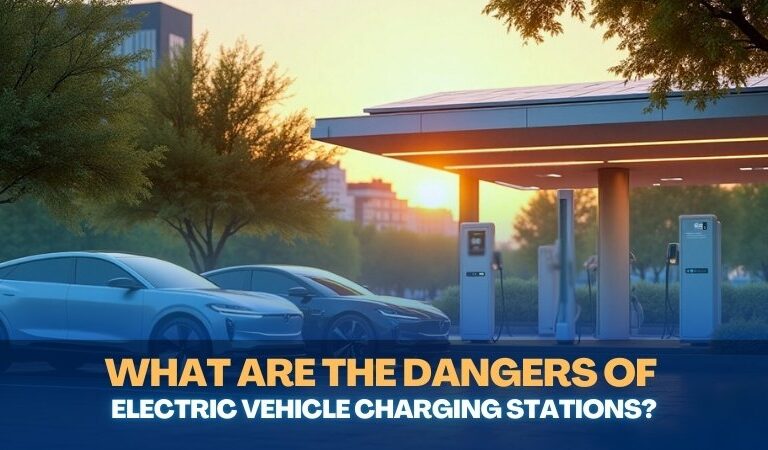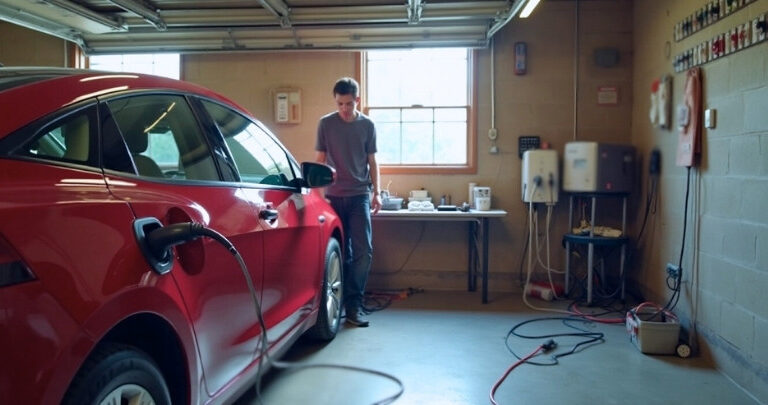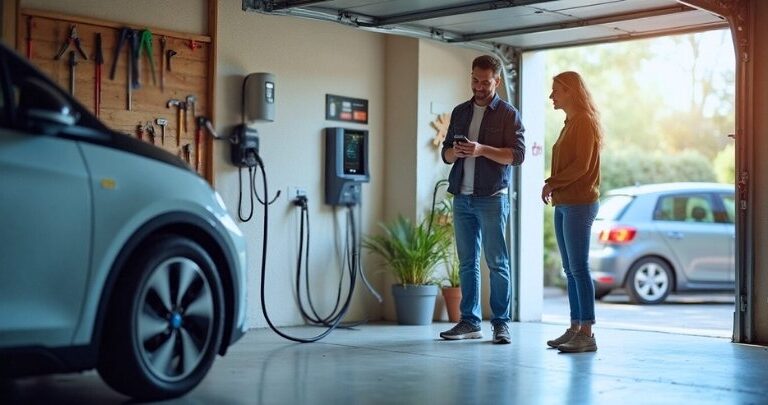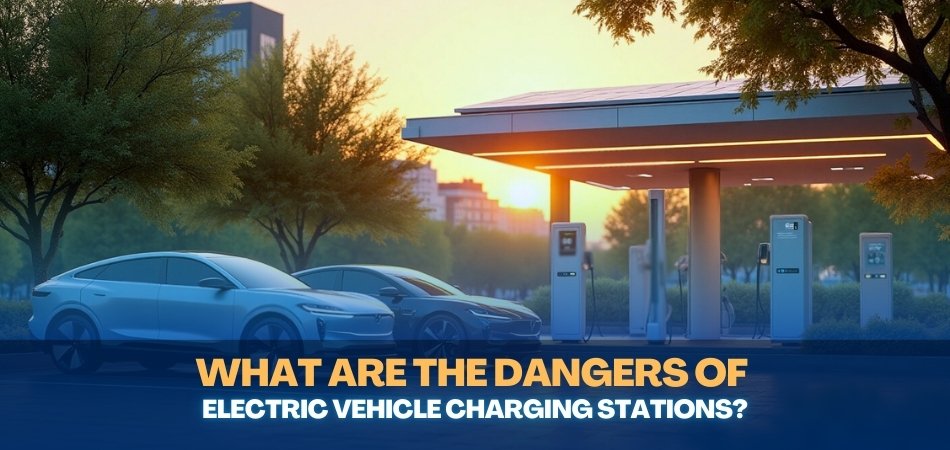Electric cars are becoming more common. They are better for the environment, cost less to run, and are quiet on the road. To keep them running, we need charging stations. But just like any other machine, these stations can also have problems.
So, what are the dangers of electric vehicle charging stations?
Some of the main risks include electric shock, fires, getting too hot, and even hacking. Problems can arise if the charger is not installed properly, if the wires or cables are damaged, or if the station is neglected. Outdoor chargers can also get damaged by rain or bad weather if they are not protected well.
Keep reading to learn more about these dangers and how to stay safe while using EV charging stations.
What are the Dangers of Electric Vehicle Charging Stations? (Explained)
Electric cars are now used more often around the world. With more EVs on the road, charging stations are growing fast. But these stations come with safety and security risks that people must know about.

Electric Shocks and Wiring Hazards
High-voltage power flows through charging cables every time you charge an electric car. If wires are broken or insulation wears off, users can touch dangerous current. Street stations may have open wires if someone breaks or steals parts.
Bad installations cause shocks when people plug in or unplug the cable. Weather can make these problems worse, especially in open charging spots. Proper cable checks lower the risk and help users stay safe while charging.
Fires from Batteries and Wires
Electric car batteries can get too hot and start fires if damaged or overcharged. These fires burn fast and release harmful gas into the air. The gas can make it hard to breathe and harm the lungs quickly.
Poor cables and full circuits can also spark fires in tight parking spaces. If someone doesn’t fix it, the fire may spread before help comes. That’s why clean wiring and strong plugs matter a lot in these places.
Accidents Around Charging Areas
Cables stretched across walkways can cause someone to trip and fall badly. Public places are full of people walking, running, or not paying attention. Tripping may hurt legs or break something near the charger.
In parking areas, people may not hear quiet EVs when they move. That leads to small crashes, which harm both people and property. Charging while moving cars nearby also makes things more dangerous in tight spaces.
Cyber Risks and Hacking Threats
Some EV chargers use the internet to work and let people pay. Hackers can break into these systems and steal account data or electricity. A person’s private info is not safe if the charger’s software has weak locks.
If someone takes control, they can shut down the charging and stop the service fully. This makes it hard for users to charge when they need it most. One hacked charger can also lead into other devices or networks nearby.
Environmental Dangers and Air Hazards
When an EV battery burns, it releases smoke that’s very bad for health. The smoke has gases like carbon monoxide that harm your lungs. Breathing this air for long can lead to health problems later in life.
In places where chargers get broken often, safety drops even more. If someone tampers with wires or parts, the whole system may fail. Fixing these chargers is important to keep both people and nature safe.
Regional Challenges in Safety
In some places, poor setup and less care lead to more problems with EV stations. A good example is the growth of electric vehicle charging station in Bangladesh, where safety and training still need more focus. With fast growth, it’s important to build strong and safe stations for daily use.
The weather, low awareness, and fewer rules can make these risks higher in developing areas. Setting better safety rules can help stop accidents and power loss. Local builders and users must work together to reduce such dangers early.
How Can Improper EV Charging Equipment Put You in Danger?
Electric cars are cool, quiet, and better for the planet. But to keep them running, they need to be charged safely. If the charging stuff isn’t right, things can go wrong fast. It’s not just about power—it’s also about safety and care.

Loose or Broken Cables
When a charging cable is broken or loose, it can cause big problems. Sparks might fly if wires touch the wrong thing. Someone could get a shock just by plugging it in. Even a small break in the cable can be dangerous. Always check the cable before using it.
Wrong Plug or Charger
Using the wrong charger might not seem like a big deal, but it can be risky. It could send too much power or not enough, which may harm the car or start a fire. Some plugs don’t fit right, and that causes heat and sparks. Always make sure the charger matches your car. A proper fit keeps things safe.
Overheating While Charging
If a charger gets too hot, it can melt or even catch fire. This mostly happens when cheap or faulty chargers are used. You might notice a burning smell or feel heat around the plug. Charging should never make you worry. If it feels too hot, stop using it.
Poor Installation Work
Sometimes the charging point at home or in a parking spot isn’t installed the right way. Wires could be loose or left open, which can cause shocks or fire. You should always get help from someone who knows how to install it. A safe setup makes a big difference. Don’t try to fix it on your own.
Water Getting Inside
Rain or water splashes can mess up the charging station if it’s not sealed well. Water and electricity do not mix—they can cause shocks or even blow up a charger. If the charger looks wet, don’t use it. Wait until it’s dry or call someone to check it. Keep outdoor chargers covered when not in use.
Trip Hazards from Cables
Long, loose cables lying around can be easy to trip over. Someone walking by might not see it and fall hard. This can also pull the charger out of the car suddenly. Always place the cable safely and keep it away from walkways. Neat cables are safe cables.
Fake or Low-Quality Chargers
Some cheap chargers look okay but are made with bad materials inside. They don’t last long and can stop working suddenly. These kinds of chargers might not protect your car or your home. It’s better to use trusted brands that are tested for safety. Spending a bit more can save a lot later.
Improper charging gear can turn something simple into something risky. Along with using the right tools, it’s also important to understand the different types of EV connectors, since using the wrong one can lead to overheating or damage. Always check your equipment before use. Safe charging protects your car, your home, and your safety.
Are EV Charging Stations Safe to Use?
Yes, EV charging stations are safe to use if people follow simple rules and use them the right way. They work well at home or in public places when set up properly and checked regularly. Most problems happen when the charger is broken or wires are damaged. It’s important to stay careful and keep the area around the charger clean and dry.
Using cheap or wrong chargers can cause heat, sparks, or even a fire. Wet or open parts of the charger can shock someone or hurt people nearby. Try not to step on the cable or pull it while walking. Just by following a few safety tips, anyone can charge their EV without worry.
How Can You Ensure Your EV Charging Area Is Safe?
Charging your electric car should feel simple, calm, and safe every single time you plug it in. But just like any machine, your charging spot needs care to stay safe. A few small mistakes can turn into big problems later on. That’s why checking your charging area is always a smart thing to do.

Clean and Dry Area
Make sure the charging area is always clean, dry, and clear of anything that doesn’t belong there. Water and dust near charging points can cause shocks or damage the charger. Wipe the plug and cables if they look dirty or wet. Avoid charging your car near puddles or wet walls. A dry space keeps everything working safely.
No Loose Wires
Loose or messy wires can cause tripping, sparks, or even short circuits. Cables lying on the ground or hanging in the air can be dangerous. You should keep all wires tied or placed neatly away from where people walk. Also, check for cuts or cracks on the cables every few days. Fix or replace them if you find any.
Proper Lighting
Charging in the dark can lead to wrong connections or missed problems like burns on plugs. Make sure your charging area has enough light so you can see everything clearly. A well-lit spot also helps you notice damaged cables or strange smells. If you charge at night, turn on an extra light nearby. Good lighting makes it easy to charge safely.
Safe Home Setup
When charging at home, make sure the outlet is strong and placed where it’s easy to reach. If the plug feels hot or loose, stop using it right away. You should also follow safe home charging practices to avoid accidents or power issues. These include using the right charger, avoiding overloading, and not using long extensions. A safe setup helps protect your home and car.
Cover from Weather
If your charger is outside, it must be protected from rain, sun, and dust. Weather can damage the charger and make it unsafe to use. Try to place a cover or small roof over your charging area. This keeps the plug dry and cool during hot or stormy days. A covered space is safer and lasts longer.
Don’t Rush the Plug
Always plug and unplug the charger slowly and carefully. Pulling it out too fast can damage the port or wire. Make sure it clicks in place before you start charging. After you finish, unplug it gently and store the cable properly. Rushing things often leads to problems you could easily avoid.
Keep Kids and Pets Away
Children and pets may touch the charger or play with the cables without knowing the danger. Always keep the charging area blocked off or out of their reach. You can place a simple warning sign or just remind them to stay away. Even when the charger looks safe, it still carries strong power. It’s better to be careful than sorry later.
What Can You Do to Avoid the Dangers of EV Charging Stations?
Charging an electric vehicle (EV) should be safe and easy. However, if not done correctly, it can pose risks. By following simple safety tips, you can avoid these dangers. Keeping these points in mind ensures a smooth experience every time you charge.
- Regularly inspect your charging cable and plug for any damage. If you spot fraying or cracks, replace them before using.
- Always use the charger that came with your vehicle or one approved by the manufacturer. This reduces the risk of electrical problems.
- Keep the charging area clean and free from clutter. This prevents tripping hazards and keeps the equipment in good condition.
- Avoid charging your EV in extreme weather, especially during rain or snow. Wet conditions can lead to electrical shorts.
- Ensure the charging station is properly installed by a certified professional. Incorrect installation can lead to serious electrical hazards.
- Never modify the charging equipment or try to fix it yourself. Always seek help from qualified technicians for repairs.
- Teach your family about the safe use of EV charging stations. Awareness prevents accidents and keeps everyone safe.
FAQs about What are the Dangers of Electric Vehicle Charging Stations?
Electric vehicle (EV) charging stations are useful, but they can also come with some hidden dangers. Many people have questions about how to use them safely. Below are some common FAQs that help explain these risks in a simple way.
Can EV Chargers Cause Power Surges at Home?
Yes, if your home’s wiring is old or weak, using an EV charger can sometimes cause a power surge. This may damage home appliances or even start an electrical fire if the circuit gets overloaded. Always use a dedicated circuit.
Is It Safe to Leave an EV Plugged In Overnight?
Yes, but only if the charger and outlet are in good condition. Faulty wires or overheated plugs can catch fire. It’s important to check everything before leaving your EV to charge for long hours, especially overnight.
Can People Get Shocked by Touching EV Chargers?
Yes, touching a damaged or wet charger can cause an electric shock. Always check the cable and plug for cracks or moisture. Never use a charger that looks broken or has exposed wires, even if it still works.
Can Overcharging Harm the EV Battery or Cause Fire?
Yes, overcharging can heat up the battery and cause it to swell or catch fire in rare cases. Most chargers stop automatically, but faulty ones might not. It’s best to unplug once the car is fully charged.
Do Charging Stations Need Regular Maintenance?
Yes, like any machine, they need regular cleaning and checks. Dust, water, or broken parts can cause fires or shocks. If ignored, small problems can grow into bigger, dangerous ones over time, especially at public charging spots.
Can Charging Stations Interfere With Other Devices?
Sometimes, yes. Poorly built chargers can cause electrical noise that affects nearby devices like Wi-Fi routers or smart TVs. Certified chargers are less likely to cause such problems and are safer for use around home electronics.
Are All Public Charging Stations Safe to Use?
Not always. Some may be damaged, poorly installed, or even tampered with. Look for signs like loose cables, burnt marks, or broken screens. If something feels off, avoid using that charger and report it if possible.
Can a Charging Station Be a Target for Hackers?
Yes, since many stations are connected to the internet, hackers can break in. They might steal data or disable the system. Using secure apps and trusted networks helps protect your information when using public EV chargers.
Concluding Thoughts
Charging your electric car can be safe if you take care and follow some simple steps. Always use the right charger, check your cables, and keep the charging area clean and dry. Knowing what are the dangers of electric vehicle charging stations helps you stay careful and avoid accidents.
These dangers include electric shocks, fire, overheating, and even hacking problems. You don’t need to worry if you check your equipment and use it the right way. Keep kids and pets away, don’t charge in bad weather, and never fix broken chargers on your own. Safe charging keeps you, your car, and your home protected.

